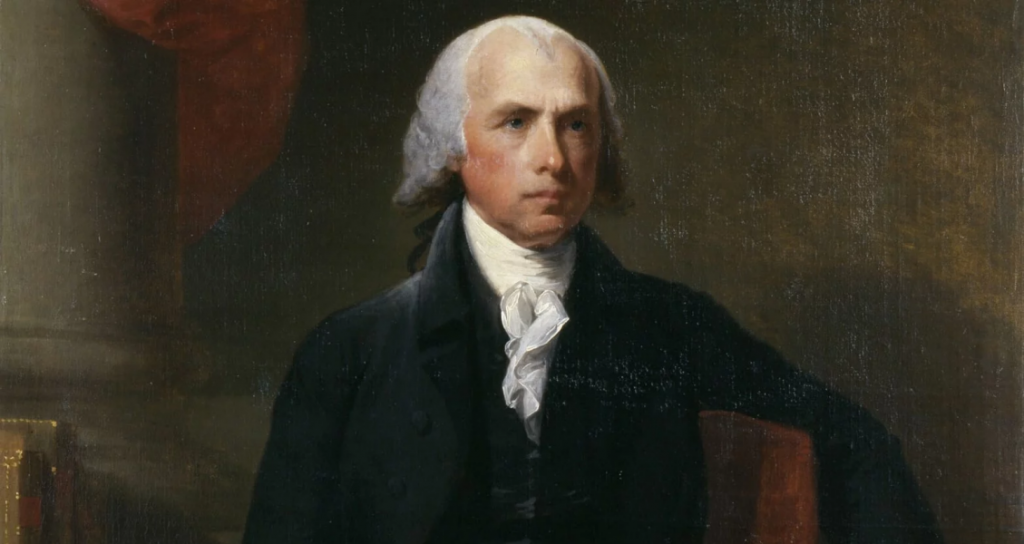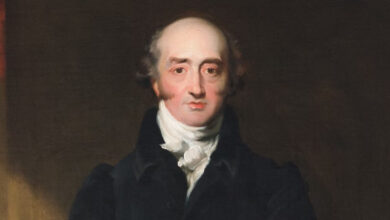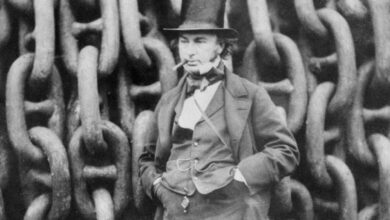
James Madison was a pivotal political figure during the formation of the United States. Although by far the shortest president at just over 5 feet tall, James Madison was a giant among the Founding Fathers. He saw the United States through its first war as a country; helped form and create a system of laws, checks and balances, and the Bill of Rights; and his wife saved the most prized treasures of American history.
Born into a wealthy plantation family from Virginia, James Madison had the best upbringing that colonial America could offer. He attended Princeton University and became the youngest delegate to the Continental Congress during the Revolutionary War.
James Madison’s early achievements were impressive, including helping to amend the Articles of Confederation which predated the Constitution, helping to enshrine religious rights, fighting for religious freedom, and after extensive study and theory looking at confederations, constitutions, and different forms of government both past and present James Madison began to build and develop the structure for what would eventually become the U.S. constitution.
Whilst the Constitution laid down the foundation for how the country should be run, there was still ambiguity related to what this meant for individuals. In 1789, James Madison proposed the Bill of Rights, which was a set of nine articles that contained about 20 different amendments to the Constitution. Most of the amendments were passed by the House, by they rejected the idea of having them in the Constitution. The first ten of these amendments officially became the Bill of Rights in 1791.
In 1794, James Madison married Dolley Payne and although they never had any children of their own, Dolley had a son called John from her previous marriage. Dolley was a talented woman and was very adept at social engagements and helped to establish what the role of the First Lady of the United States would eventually become.
James Madison was an important Founding Father and continued to see improvements in his political fortunes. He helped found the Democratic Party with Thomas Jefferson which opposed the policies of the Federalist Party.
In 1801, Thomas Jefferson became the third President of the United States and he selected James Madison as Secretary of State, and in the same year, Madison’s father died, meaning that he inherited Montpelier, the tobacco plantation in Orange County, Virginia, along with its 108 slaves. He remained the owner of the plantation and most of the slaves until he died.
Towards the end of Jefferson’s second term as president, James Madison decided that it was time to run for office himself and ran against the Republican John Randolph. He won the contest with a comfortable margin and was inaugurated as the fourth President of the United States in 1809.
Tensions with Great Britain had been growing for quite some time even after the conclusion of the Revolutionary War, with the British in its war with Napoleon in France even pressing American seamen into service in its Navy. That Americans were being forced to fight for another country against their will was too much for the young republic to bear and the United States government felt this action was an outrageous affront to American sovereignty. There were also some people in the government who actively sought war with Great Britain in the hope of taking Canada, and so with an official declaration from Congress passed on 18 June, the War of 1812 began.
Britain at first was not able to fight back in any meaningful way due to being busy in France; but a failed American expedition to seize Canada gave the British some breathing room and with the momentum in the war with France turning its way, it was able to turn its attention to the United States.
In 1814 the British landed troops and began their march towards Washington, DC. The poorly trained American defenders were swept away and while James Madison himself was out rallying the troops, the British marched into the capital. Servants working in the White House attempted to get the first lady, Dolley Madison to leave, but she refused until they agreed to take the picture of Washington that hung on the wall and the Declaration of Independence. The picture was firmly mounted to the wall so in a daring move, Dolley gave the famous order to break the frame and take the picture. Wrapping these priceless treasures in quilts, she sped out of the capital and was one of the last to leave the city.
The British, shortly afterwards, entered the White House and after enjoying the evening meal that had already been set out for the Madison family, burned it and all other federal buildings, except the post office, to the ground.
The British army did not stay long though, as a fierce storm gathered which sent driving rain to put out the fires in Washington. The storm also spawned a tornado which touched down near the city sending British cannon flying. Some took this as a sign that their burning of homes and libraries in the capital had offended God. The British swiftly withdrew from the city but the Madisons would never live in the White House again.
The war ended in 1815 and James Madison for the final two years of his second term as president saw the country enter the “Era of Good Feelings”, with the Federalist party failing to offer an effective opposition. In 1816, he and Thomas Jefferson lent their support to Secretary of State James Monroe, resulting in him easily defeating the Federalist Rufus King to become the fifth President of the United States.
Although his presidency was over, and he had retired to Montpelier at the age of 65, James Madison continued to occasionally be involved in politics, providing advice to Andrew Jackson and other presidents. He also helped found the University of Virginia with Thomas Jefferson and was appointed as its second rector on Jefferson’s death in 1826, a post he held until his own death ten years later.
James Madison’s mental and physical health began to fail as he became more and more concerned about his legacy, even resorting to amend and “straighten out” letters and other documents that were still in his possession, even going to the length of attempting to forge Thomas Jefferson’s handwriting with the aim of ensuring that people understood him.
James Madison died of congestive heart failure at the age of 85 on 28 June 1835 at his home at Montpelier, where he is buried.




